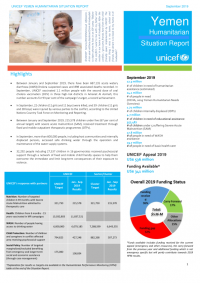UNICEF Yemen Humanitarian Situation Report (September 2019)
Highlights
• Between January and September 2019, there have been 687,135 acute watery diarrhoea (AWD)/cholera suspected cases and 898 associated deaths recorded. In September, UNICEF vaccinated 1.1 million people with the second dose of oral cholera vaccination (OCV) in three high-risk districts in Amanat Al Asimah; this number accounts for 93 per cent of the campaign’s target, a record achievement.
• In September, 22 children (11 girls and 11 boys) were killed, and 39 children (11 girls and 28 boys) were injured by various parties to the conflict, according to the United Nations Country Task Force on Monitoring and Reporting.
• Between January and September 2019, 215,578 children under five (67 per cent of annual target) with severe acute malnutrition (SAM), received treatment through fixed and mobile outpatient therapeutic programmes (OTPs).
• In September, more than 600,000 people, including host communities and internally displaced persons, accessed safe drinking water through the operation and maintenance of the water supply systems.
• 32,292 people including 27,537 children in 16 governorates received psychosocial support through a network of fixed and mobile child friendly spaces to help them overcome the immediate and limit long-term consequences of their exposure to violence.
12.3 million
# of children in need of humanitarian assistance (estimated)
24.1 million
# of people in need
(OCHA, 2019 Yemen Humanitarian Needs Overview)
1.71 million
# of children internally displaced (IDPs)
4.7 million
# of children in need of educational assistance
357,487
# of children under 5 suffering Severe Acute Malnutrition (SAM)
17.8 million
# of people in need of WASH assistance
19.7 million
# of people in need of basic health care
Situation Overview & Humanitarian Needs:
In September, numerous incidents continued to occur across the country highlighting the ongoing conflict and volatility of the context. On 1 September, airstrikes hit a former community college compound in Dhamar city, where 170 prisoners were being held in a detention facility in the compound. More than 100 people were killed from the airstrikes. On 13 September, shelling in Al Hudaydah killed 11 people including seven children. On 23 September, airstrikes hit a mosque in Al Sawad in Amran governorate and killed seven people including women and children from the same family. On the next day, 15 people were killed, and 15 people were injured by airstrikes that hit a house in Al Fakhir in Al Dhale’e governorate.
During the reporting period, the United Nations Country Task Force on Monitoring and Reporting verified 88 per cent of reported incidents, including 22 children (11 girls and 11 boys) killed, and 39 children (11 girls and 28 boys) injured, perpetrated by various parties to the conflict. Most of the incidents documented and verified were in the governorates of Al Hudaydah followed by Al Dhale’e and Al-Byda’a. So far in 2019, 699 children (202 girls and 497 boys) were killed or maimed by various parties to the conflict. Child casualties recorded between January and September 2019 decreased by 47 per cent compared to the same period of 2017 (1,315 children; 292 girls; 1,020 boys; 3 unknown gender).
Since the second wave of acute watery diarrhoea (AWD)/cholera outbreak on 27 April 2017, the cumulative total of suspected cholera cases as of 30 September 2019 reached 2,091,442 with 3,656 associated deaths (case fatality rate [CFR] 0.17 per cent). Suspected cholera cases have increased since the start of 2019, with 320 out of 333 districts reporting suspected cases. Between January and September 2019, there have been 687,135 suspected cases and 898 associated deaths recorded (CFR 0.13 per cent). Thanks to the enormous efforts done by all the humanitarian partners to respond to this epidemic, the weekly number of deaths associated to AWD was divided by 3.6 between the week 14 that has recorded the highest number of cases in 2019 and the week 39 that corresponds to end of September. The average weekly case fatality rate is remained at a low level, around 0.08 per cent in average, since beginning of May. The proportion of children under 5 years represented 18 per cent of cases at the 2019 epidemic peak versus 30 per cent of cases end of September. This change in the age distribution of cases may reflect a switch in the predominant etiological cause of the AWD, that may not be all cholera cases. While children under five representing 25 per cent of the total suspected cases, the elderly are most seriously affected where deaths are higher among the people over 60 indicating possible comorbidity causes. The suspected cases (85,965) in September 2019 were increased by 25,731, comparing to September 2019; however, the associated deaths were decreased from 107 in September 2018 to 81 in September 2019.
https://reliefweb.int/report/yemen/unicef-yemen-humanitarian-situation-report-september-2019

